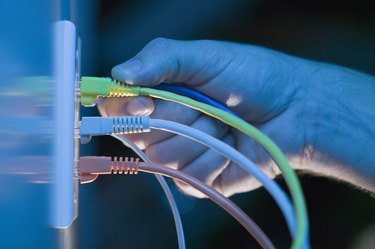
Hierarchical network design provides efficient, fast and logical traffic forwarding patterns for enterprise network topologies while minimizing the cost of connecting multiple devices at network endpoints. First submitted as a best practice by Cisco in 2002, hierarchical network topologies adapt well to business expansion, traffic shaping and network security models by segregating a LAN (Local Area Network) into logical parts that correspond to needs of the organization.
Ease of Design
Video of the Day
Hierarchical networks are among the easiest to design and implement as equipment and cables generally follow the logical structure of an organization. Starting from a single or multiple points of traffic egress and ingress, routers and switches delimit different organizational units until the final end-user is left with a single Ethernet adapter or 802.11 WiFi network access point. Clear organizational boundaries separate segments of the network, allowing for straightforward initial setup, and logical modifications should organizational network needs change.
Video of the Day
Traffic Multiplexing
Traffic multiplexing refers to the idea that multiple users' network traffic can travel over the same network cables and intermediate routing equipment. In a hierarchical network schema, traffic starts out with little multiplexing for intra-domain routing, and as the traffic travels further and further away from its source becomes more multiplexed. Dense traffic multiplexing of inter-domain network traffic (over the public Internet) allows businesses to save money on ISP (Internet Service Provider) costs, while sparse multiplexing for intra-domain traffic allows hosts within the same organization to talk to each other faster by capitalizing on inexpensive and fast commercially available network hardware.
Equipment Cost Savings
IT networking equipment, such as routers, switches, cables and wireless access points are expensive but essential elements of an organization's everyday operations. Implementing a hierarchical network design often saves an organization money by reducing the amount of equipment needed to set up a network initially to only what is absolutely necessary given the organizational structure. Adding to an existing hierarchical network is modular, so additions to network equipment scale linearly in cost. For example, adding a single user is often as inexpensive as a single Ethernet cable and host computer.
Security
For IT management, hierarchical networks allow for fine-tuned access control lists, traffic shaping and blocking unwanted traffic. These can be implemented on a user, department or organization-wide basis, providing fully customizable network traffic plans for IT staff. Details of the network are abstracted away for users, greatly reducing accidental or intentional network faults. This in turn directly increases a business' earning potential--increasing productivity, eliminating unwanted and malicious traffic and speeding up the network for legitimate use.